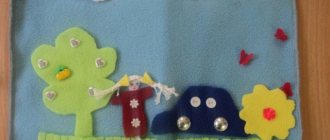The Importance of Creative Play for Preschool Children
«The Importance of Creative Play
for preschool children
»
Creative play is play that is created by children themselves. In them, the game plot is determined by the players themselves, there is no set program for children’s behavior, and the child’s actions in an imaginary situation and its comprehension come to the fore.
Theoretical ideas about the essence of children's play, developed in Russian psychology, basically boil down to the following:
- The game takes its place among other reproductive activities, being the leading one in preschool age. It is in the process of play as a leading activity that the main mental new formations of a given age arise.
- The game is a special activity, social in origin, content and structure.
- The development of play does not occur spontaneously, but depends on the conditions of the child’s upbringing, i.e. social phenomena.
The problem of teaching play, its formation as an activity, stood out and was most clearly formulated in psychological and pedagogical studies of young children and abnormal children. This problem is clearly formulated by A.V. Zaporozhets.
As a result of psychological research, practical pedagogy turned out to be focused on the formation of actual play activity in young children. However, in relation to preschool children, pedagogical guidance of the game was reduced mainly to enriching the specific content of the game, to organizing positive relationships in the game.
Meanwhile, conditioned play action, which is formed in early childhood and is, of course, the basis of a more complex game of a preschooler, does not yet provide a transition to it (with role-playing behavior and creative plot construction lying at its center). As a result, the game is extremely monotonous. Often, even by older preschool age, children’s play activity does not reach its developed forms. This forces us to pose the problem of the formation of play activity more broadly - as the problem of the gradual transfer to children of increasingly complex methods of play activity throughout preschool childhood.
In connection with this problem, a number of more specific problems arise:
- what methods of play should be developed in a child and in what sequence;
- what nature should the formative influences of an adult have, and under what conditions will they be most effective;
- what forms of play will most contribute to the mental development of the child at each stage of preschool age.
It is possible to approach the solution of these problems only by first considering the question of the importance of play for the development of a child.
The developmental functions of the game are more clearly defined in Russian psychology and pedagogy.
Considerations expressed by L.A. are essential for understanding the developmental significance of the game. Wenger, who emphasized the need to clearly define the specific influence of play on a child’s development. Wenger proceeds from the fact that each specific activity requires certain abilities specific to it and creates conditions for their development.
D.B. Elkonin, considering the developmental function of the game, dwells, first of all, on its significance for the development of the motivational needs of the child’s sphere.
L.S. points out the development of the child’s imagination and imaginative thinking in play. Vygotsky, D.V. Medzheritskaya.
Learning and development of creativity occurs in unity and interaction. This was convincingly proven by E.A. Flerina, who criticized the “theory of decay” of children’s creativity. E.A. Fleurina has proven that decline can come from lack of training or poor training; With proper guidance and training, children's creativity reaches a relatively high level.
The works of educational psychologists analyze the significance of the game for the moral development of the child, primarily the role of the content of the game itself, through which the child masters the norms and rules of relationships between people.
According to R.I. Zhukovskaya, children are united in play by a common goal, common interests and experiences, joint efforts to achieve a goal, and creative searches.
T.A. Markova believes that the development of friendship between children is significantly influenced by long-term creative play.
Playing together creates the conditions for the emergence of a “children’s society” and real relationships between children in it. A.P. Usova sees the main educational significance of the game precisely in the presence of “social” qualities in children, i.e. qualities that enable you to interact successfully with others.
Already existing ideas about the developmental significance of an expanded form of play activity need to be supplemented with data on how play influences the child’s development at each age stage. So far, science does not have such specific data. Therefore, it is necessary to consider play activity from the point of view of the consistent complication of its structure and trace the possibilities and characteristics of children mastering it at different age stages.
The solution to this issue requires the fusion of psychology and pedagogy. In a new type of research - psychological and pedagogical, where the features of the development of a child’s play activity are studied in the process of its active formation. Vygotsky pointed out the need for this type of research. This idea was further developed in the works of psychologists V.V. Davydova, D.B. Elkonina.
In the psychological studies of A.N. Leontiev, D.B. Elkonin and others considered the development of children's play from the point of view of the dynamics of motivation and changes in the psychological content of activity.
First stage
The development of play is associated with the child’s mastery of the specific functions of objects that are inaccessible to him in his practical activities - practical play.
Second phase
The development of the game is associated with mastering the relationships between people that mediate the relationship to the subject - role-playing game.
Third stage
- highlighting the hidden tasks and rules of human actions and relationships in these relationships - a game with rules - and a shift in motive from the process of activity to its result - a dramatization game and a fantasy game.
Children's games are extremely diverse in content and nature of organization, so their exact classification is difficult.
The basis for the classification of games, which is accepted in Russian pedagogy, was laid by P.F. Lesgaft. He approached the solution to this issue, guided by his basic idea of the unity of the physical and psychological development of the child.
In domestic pedagogy, the question of the classification of children's games was clarified in the works of N.K. Krupskaya. In her works, she highlights games that are created by the children themselves, and those that are organized, with ready-made rules.
Offline games
6
Game "Let's write..."
Within a minute, try to name as many things as possible that are currently in the room with you and begin with the letter: “K.” The letter “P”... And the letter “B”? Count how much you got. If you try, you can name more than 50 things, or even more than 100. To improve this exercise, think about what groups of surrounding objects you forgot to include.
For example, starting with the letter “B” you can name:
- things, hanger, (items);
- screws, introduction to the book on the shelf, (details of objects);
- tungsten lamp filaments, felt, cotton wool, viscose, etc. (materials);
- pile on the carpet, wax on the parquet (coating);
- hair, eyelids, freckles, temples, etc. (body);
- imagination, delight, excitement, the ability to come up with something else (mental concepts);
- air, breeze, variants of words, yourself, everyone else (also with “v”).
Think what else can be called? Practice with other letters: “p”, “k”, “s” - easier, “d”, “a”, “t” - more difficult.
7
"Complete the drawing"
This game can be played by two or by a large group. The rules are that one person draws, without looking at the paper, several lines or a figure, and the second person must complete it as creatively as possible so that a complete picture is obtained. Then the players change.
8
Burime
Burime has already won an army of fans for quite a long time (the game has been known since the 17th century) and remains popular among lovers of an interesting and useful pastime. Today, from the last desks of schools and universities, it has moved to the Internet, where you can always find someone to play with.
The essence of this creative literary game is the collective writing of poetry. All you need is company, a piece of paper and a pencil. There are several options for burime. In the classical version, the rhymes and themes of the future verse are agreed upon in advance. They try to choose unexpected, contrasting rhymes, while avoiding auxiliary words, pronouns, cognates and verb forms (tide, gone, come), as well as hackneyed expressions (love-blood, April-drops).
A more cheerful variety of burime, loved by students, is the writing of humorous rhymes. Sometimes also called the “game of nonsense.” It is played like this: the first participant writes a line or several (the funnier and more senseless, the better) and folds over part of the sheet with what was written, after which the second participant continues, but knows only the last word or line written by the previous one. The end result is a rather funny poem.
9
Hat
Hat is a team intellectual creative game for guessing words. In stores you can often find the board game “Hat”, with pre-prepared cards with words and explanations. But you can play it without special props, and the rules are quite simple.
A minimum of 2 pairs of players is required to play. Everyone writes 10 words on a piece of paper, after which they are all mixed in a hat (hence the name, but you can use any material at hand for this purpose). Words must be common nouns in the nominative case, by agreement - fictitious names, etc. Then the presenter or the players themselves time 30 (for experienced 20) seconds - the end. During the con, the team (pair) must guess as many words as possible. One takes out a card, reads to himself and tries to explain to the second what the word is written on it. In this case, it is prohibited:
- Use of cognate words (the word “corral” cannot be explained using the word “drive”). If the hidden word is multi-rooted, then not a single root can be used in the explanation.
- Using direct translations of words or their roots into other languages (you cannot explain the word “dining room” using the word “table”)
- Using direct translations of the roots of foreign words (the word “liberal” cannot be explained using the word “freedom”)
- Using gestures (including pointing to objects)
- Use of consonant words (the word “tavern” cannot be explained using the words “tobacco” or “boar”).
You can use similar-sounding words, synonyms, lengthy explanations, metaphors and other techniques that do not contradict the above rules. At the same time, words that are consonant with the meaning also need to be explained, and not named directly. When the team guesses the word, they get the next piece of paper. After 30 seconds, the second team enters the game and so on alternately until all the words have been guessed. The pair that guesses the most words wins.
There is also a three-round version of the game. The first goes as in the original game, in the second those same cards need to be guessed using one word and pantomime, and in the third - only with the help of pantomime (gestures).
10
Creative TRIZ game for children
There is a special section in the Theory of Inventive Problem Solving - TRIZ pedagogy. Its goal is to educate from preschool age a personality capable of solving open-ended problems. The TRIZ training program is built, among other things, on the use of various games and exercises that help develop imagination, associative thinking, and logic. Here is an example of one such game; more can be found in books and resources, the list of which is here.
Give your child a piece of paper and a pencil. Turn on some light music, ask them to close their eyes and draw whatever they want, without thinking about shape or location. Let it be several drawings that overlap each other. Afterwards, with your eyes open and colored pencils, try together to find the most bizarre images at the junction of what you have drawn and color them.
11







